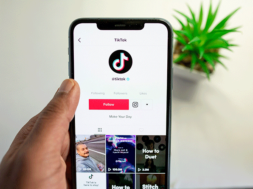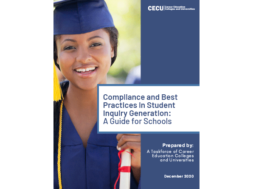
By Chris Linford, CEO, Oozle Media
Around 90 percent of people read online reviews (Bright Local). In fact, 84 percent of people trust reviews like a personal recommendation. Knowing these statistics, it shows just how important it is for career schools to make sure that not only are they getting reviews, but they are getting reviews that people can trust. Approximately 63 percent of consumers use search engines like Google to find reviews, so it’s important to know what to do with the reviews people leave on Google.
Why are Google reviews so important?
Google reviews can help your school rank higher on Google Maps. The higher your ranking on Google Maps, the more likely a potential student can find your school.
However, ranking high isn’t as simple as getting all positive reviews. There are a number of factors that affect your ranking on Google.
Some of those factors include the number of reviews, the frequency of reviews, where the reviews came from, how descriptive those reviews are, and the actual rating of each review. When it comes to Google reviews, not only are there some things you should be doing as a school, but there are some things you should avoid, too.
How to get the best Google reviews (and avoid the bad ones)
If you’re looking to get the best Google reviews, there are a number of things to watch out for. While having reviews is a great start, there are some reviews that could be considered “bad” and actually hurt your ranking on Google Maps, even if they have a 5-star rating. Here are four things you should avoid when working towards getting good Google reviews.
First, avoid a low frequency of reviews. Imagine a cosmetology school that started asking salon guests and students for reviews. That school might get 50 reviews in one day, stop, and say that’s enough. But that looks unnatural in Google’s eyes, which means that the school will actually rank lower on Google Maps even if they have a good number of reviews. If you start asking for reviews, never stop asking for reviews. If your school gets 50 reviews in a few days, don’t suddenly stop asking. Google’s smart. It’s looking for natural review patterns to determine what schools to rank higher on its search results.
Second, avoid having your reviewers connected to your Wi-Fi. This is a little-known issue with reviews. Google’s review policies state, “If you’re a business owner, don’t set up review stations or kiosks at your place of business just to ask for reviews written at your place of business.” This goes for schools, too. The reason for this is because it looks like the school is using the kiosk to write reviews that aren’t authentic. However, there’s more to this policy. Not only should you not set up a kiosk, but you shouldn’t have reviews come from the same IP address. Each Wi-Fi access point comes with one IP address, and if all reviews are coming from that one access point, then Google sees those reviews as unnatural. Even if all of your reviews are coming from different devices, Google still doesn’t like it. If your students and guests are connected to your school’s Wi-Fi when they leave reviews, Google doesn’t think those reviews are authentic. The most natural review will be from someone who writes it from their phone, using their own data.
Third, avoid having non-descriptive reviews. While having reviews is great, you want to encourage the reviews you receive to be descriptive. This is because the most recent review doesn’t always float to the top.
When looking at Google reviews, which ones are at the top? The ones with paragraphs of text rather than those with a simple star rating.
In other words, the descriptive ones are at the top. The problem is that the reviews with blocks and blocks of text are usually those that are negative. This is because when people are mad, they’re motivated to type more.
The question is, how do we get our students and guests (not just the ones who had a negative experience) to be descriptive? We ask them! When asking for reviews, ask a potential reviewer to talk about their experience. Ask them to talk about the exact service they received there, who did it, and how the experience was. By asking for descriptive reviews, you help potential students and your keyword ranking.
What some people might not know is that people love descriptive reviews. It gives people good context about the school. That context also allows your school to rank higher with keywords. Here is a short example of how descriptive reviews work. If you’re running a cosmetology school and ask a student to give a review about their experience, you might get a review that says something like, “I love this school! I’m getting a great education, and I can’t wait to start my beauty career!” From this short review, that cosmetology school is now more relevant for keywords such as “school,” “beauty,” and “education.”
The real question is, how do you get those descriptive reviews? Ask for a review as an individual, not a school, especially with guests at the salon. Use phrases such as, “It would mean a lot to me to get feedback,” or “If you left me a review and mentioned my name, that would mean a lot. Would you do that for me?” The key to getting the best and most descriptive reviews is to put the emphasis on you, as an individual, who’s asking for the review.
Other places offer an incentive to people who leave reviews, and the reviews they receive aren’t as descriptive, sincere, or genuine. If you offer an incentive, you might find more star rankings rather than actual, descriptive reviews, which might appear to be good, but all-positive reviews can actually look bad in Google’s eyes, since Google doesn’t think those reviews are authentic.
Fourth, avoid all positive or all negative reviews. Believe it or not, a school with all positive reviews and no negative reviews may rank lower on Google Maps than a school with a mix of positive and negative reviews. That’s because all negative or positive reviews don’t look natural in Google’s eyes. Also, people may become suspicious of a school that only has positive or negative reviews. If the reviews are all positive, students and guests don’t know what the school will do if something goes wrong.
Having a variety of reviews, positive and negative, can build a potential student’s trust with a school.
If a potential student sees a negative review but also sees a response from the school, that student now knows what the school will do if someone isn’t happy with their experience. If a student sees a negative review without a response, that student might be deterred from touring that school because they don’t know how the school will help them if they have a bad experience learning there.
Why should you respond to those reviews?
Any response shows that you’re listening to what your students have to say about your school and that you want to continue to improve your student’s experience. It’s also important that if you see a review, respond quickly. Google shows your potential students when you respond, and responding to reviews quickly is another part of Google’s algorithm. Both responding to reviews and responding quickly can improve your rankings on Google Maps. The faster the response time, the better.
How should you respond to positive reviews?
If someone likes your business, then you don’t need to respond to their review, since there’s no problem, right? Wrong. It’s best practice to respond to all reviews, even if they are positive. When responding to a positive review, keep the response short and sweet, but add a little splash of personality. Mention the reviewer by name, thank the reviewer for the kind words, and mention something specific from the review. By mentioning something specific, it shows the reviewers that you actually took the time to read their reviews.
How should you respond to negative reviews?
Responding appropriately to a negative review can gain a potential student’s trust and make them more likely to tour the school or visit the salon. When responding to a negative review, do not get angry or try to prove the reviewer wrong. Here are the steps you should take to properly respond to a negative review.
- Use the first name of the reviewer.
- Thank the reviewer for bringing the problem they had to the attention of the school.
- Put the reviewer’s problem into a general standard your school has and promise that you care about that standard. For example, if someone complains about having instructors who don’t care about them, then explain that your school does care about students individually.
- Provide contact information, such as an email or an office number with an extension to an employee with a higher position, such as a school director.
- Ask the student to call or email and resolve the issue offline. Do not try to resolve the issue in your response to the review or anywhere online where others can see the exchange.
- If the student contacts you, resolve the issue and ask the student if they would be willing to update (not delete) their review.
Why ask reviewers to update their negative reviews?
The last step to a negative review response is to ask your student to update their review rather than delete it if the issue was resolved. These reviews can actually be the most valuable, as they prove that not only are you willing to help the student if something goes wrong, but you actually go through with it. Reviewers might change their 1-star review to a 2 or 3-star review, and those are the reviews people read after a few negative reviews because they are the most genuine. An updated review from a student who had a negative experience is worth more than hundreds of positive reviews. This is because a potential student is more likely to trust an honest, sincere experience even if it wasn’t necessarily a good one.
How can negative reviews help a school build trust with their students?
When a potential student sees a response to a negative review, that student can see that your school cares for its students. People want to know that no matter what happens, they’ll be taken care of and that the school will help them reach their goals and aspirations.
Your negative reviews won’t just go away. In fact, those looking to advance their education are more likely to read the first review, scan it, and then go straight to the negative ones. These individuals want to know what they are potentially getting themselves into.
If they see a negative review without a response, they don’t know what will happen if something goes wrong, and ultimately will feel like the school doesn’t care much about its students.
If they see a response that shows these potential students that no matter what happens the school will do its best to make it right, then everyone knows they can trust the school in the end. A good response builds trust.
A response to a negative review shows the world that you care about your students and your students can trust your school and have a good experience. The more trust you build with your reviews, positive or negative, the more students you’ll attract.
References
https://www.brightlocal.com/learn/local-consumer-review-survey/
http://searchengineland.com/88-consumers-trust-online-reviews-much-personal-recommendations-195803
https://www.reviewtrackers.com/google-reviews-important-reviews/
https://support.google.com/business/answer/2622994?hl=en&ref_topic=6001257
CHRIS LINFORD, a name only spoken of in hushed, reverent tones, is the devilishly handsome, overly talented, and very humble CEO of Oozle Media. It’s been said that when a beauty school hires Oozle to help them with their website, social media, SEO, and pay-per-click, they’ve just killed two stones with one bird. Seemingly insignificant and small schools such as Aveda, PCI, Rosedale Tech, Paul Mitchell, The Salon Professional Academy, Ogle Schools, Evergreen Beauty College, and many others have had levels of satisfaction (at times) that can only be compared to the feelings one would have after hearing the announcement of the abolishment of Gainful Employment, when working with Oozle Media. One more worthy thing to note about Chris is that although he hails from Utah, has three kids, and one on the way, he does only have one wife whom he loves very much, and has been proudly married to for over 12 years!
Contact Information: Chris Linford // CEO // Oozle Media // 801-562-8557 // clinford@oozlemedia.com // oozlemedia.com // https://www.facebook.com/oozlemedia/ // https://twitter.com/oozle_media // https://www.instagram.com/oozle_media/











